The current U.S. labor market is unparalleled, and in many ways unexpected and seemingly inexplicable. This Backgrounder examines the labor market that is proving so difficult for employers and consumers across the U.S., by diving deeper into the employment trends among different groups of workers with data through December 2021.REF
Total Employment Gap
With 155.7 million employed workers, employment today is 2.3 million (1.4 percent) below its pre-pandemic February 2020 level.REF Compared to a steady-state growth of about 84,000 jobs (0.53 percent) per month, total employment today is 4.1 million (2.6 percent) below where it might have been without the pandemic and absent other changes in economic conditions.REF A different methodology, using data on the “active population” (a metric from the Organization of Economic Co-operation and Development that includes people who supply labor)REF of people ages 15 to 64 yields a similar employment gap.REF
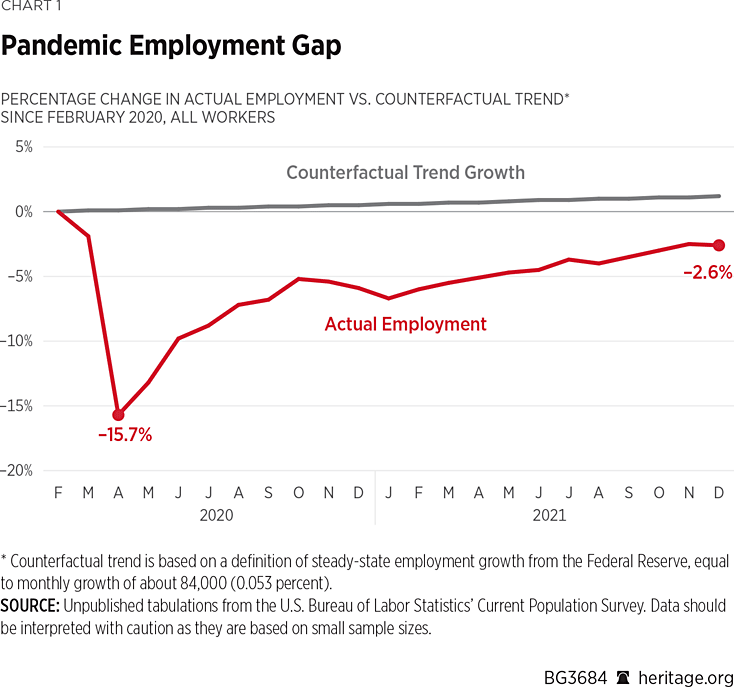
The Labor Shortage
In contrast to what was expected to be a weak labor market as the U.S. economy recovered from—and continued to confront—the COVID-19 pandemic, the labor market has arguably never been stronger for workers. The 4.1 million employment gap is entirely a labor-supply problem—as opposed to a lack of labor demand. In fact, absent the shortage of willing workers, employment would likely be above trend right now, with an employment surplus instead of a gap.
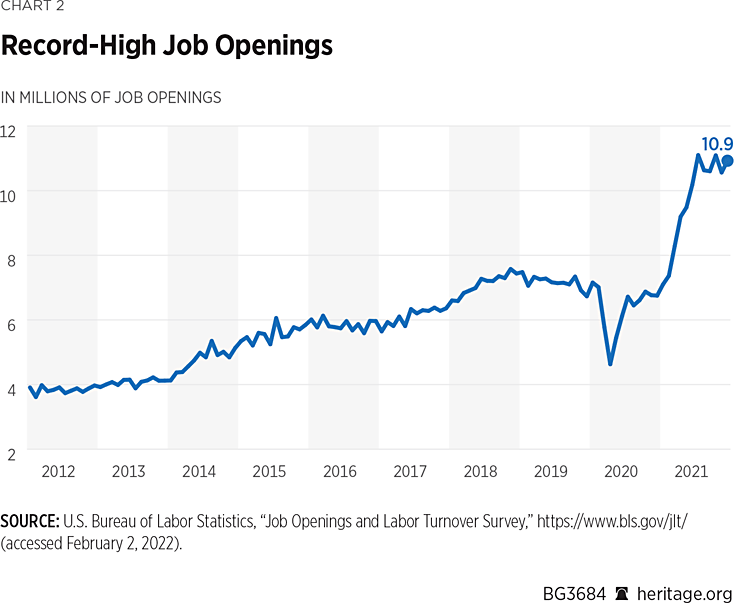
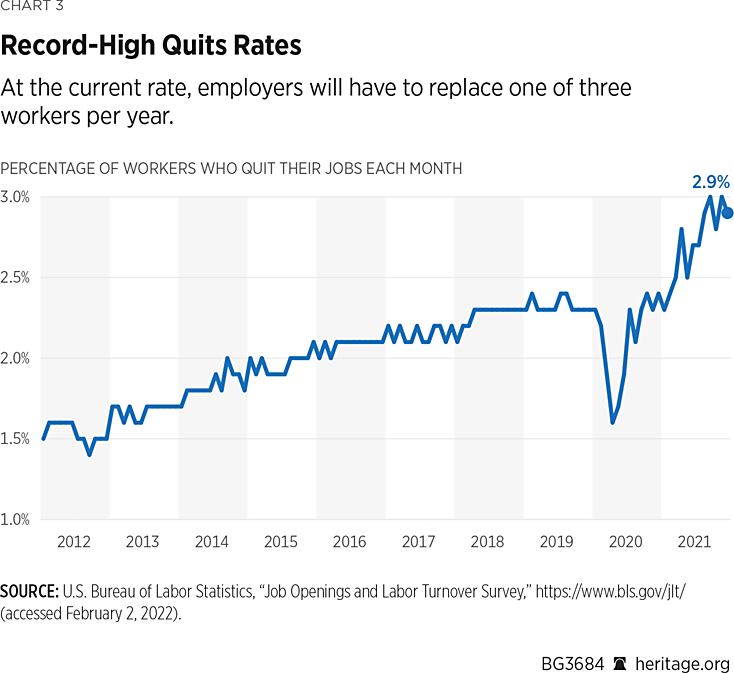
The current 10.9 million job openings (December 2021) are 3.4 million above the pre-pandemic high and indicative of how difficult it is for employers to find the workers they need.REF Simultaneously, workers are quitting their jobs at record-high rates. In 2021, 47 million workers quit their jobs, requiring employers to replace 11 million more workers than they had to in 2020 (and 14 million more than the average between 2011 and 2020). With 4.3 million (2.9 percent) of workers quitting their jobs each month over the past six months, this pace translates into employers having to replace 35 percent of their workers (more than one of three) over the course of a year.
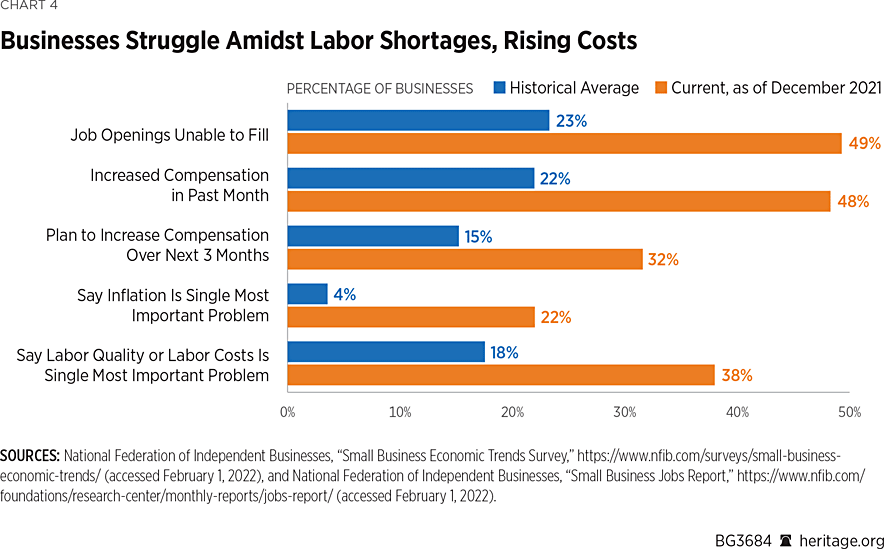
According to the National Federation of Independent Businesses, 49 percent of businesses had job openings that they were unable to fill in December 2021, with 95 percent of those businesses saying that they had no or few qualified applicants.REF The labor shortage has caused employers to raise compensation, with a record-high 48 percent of businesses reporting that they increased compensation in December, and another 32 percent saying that they plan to raise compensation over the next three months.REF Although hourly pay increased by an above-average 4.7 percent over the past year (December 2020 to December 2021), real average earnings (taking into account the effect of inflation) were down 2.4 percent.REF
The Demographics of the Employment Gaps
Throughout the pandemic, different groups of workers have been affected differently. For example, at the beginning of the pandemic, lower-wage workers and women who were caregivers were more likely to have lost or dropped out of employment, and older workers faced greater health concerns from COVID-19. Tabulations based on unpublished data from the Bureau of Labor Statistics’ Current Population Survey provide additional information on employment trends, such as by age, gender, and the presence of children in the home.REF
Table 1 provides a breakdown of the employment gaps for various groups of workers, as measured by the percentage difference between current employment (December 2021) and where it would have been if, absent the pandemic, employment had followed steady-state employment growth.
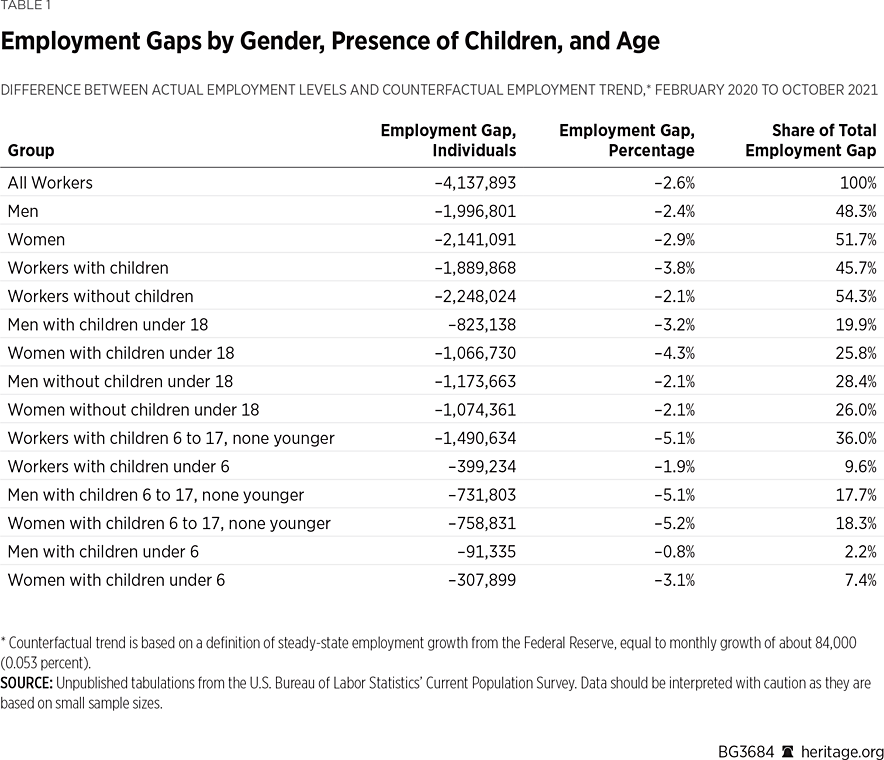
Women currently make up a greater share of the employment gap, representing about 2.1 million workers, which is 52 percent of the gap, with men making up 2.0 million, which is 48 percent, of the gap. Workers with children have a larger employment gap than those without (3.8 percent vs. 2.1 percent), but because there are fewer workers with children in the labor market, they comprise a smaller share of the employment gap at 46 percent.
Differences in employment by gender only exist among workers with children, as men and women without children have identical employment gaps of 2.1 percent. While the employment gaps for men and women with school-aged children (ages six to 17) are also nearly identical, they are more than twice the gaps of workers without children, including a 5.1 percent employment gap for men with school-aged children and a 5.2 percent gap for women with school-aged children.
Despite stories of childcare struggles, workers with children under age six have a smaller employment gap (1.9 percent) than workers without children (2.1 percent), and they make up only 9.6 percent of the overall employment gap. Within this group of workers with children under age six, women have a larger employment gap (3.1 percent) than men (0.8 percent).
Men vs. Women. Initially, between February 2020 and April 2020, women’s employment declined by 2.2 million more than men’s, as women experienced an 18.1 percent employment gap and men experienced a 13.6 percent gap. The primary reasons that COVID-19 affected women disproportionately was that women made up a higher percentage of workers in the industries that were most affected by COVID-19 shutdowns, and they also were more likely to be the primary caregivers for children whose schools and daycares had closed.
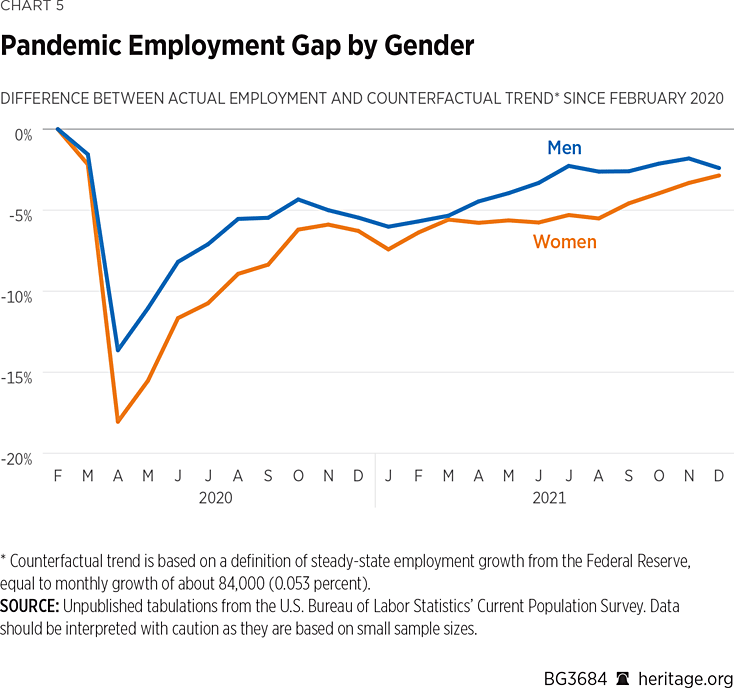
Men’s and women’s employment gaps narrowed through March 2021, at which point the women’s employment gap was 5.6 percent and the men’s was 5.3 percent. The gap then increased as women’s employment gains leveled off as men’s rose during the summer. Over the past few months, women’s employment has improved more then men’s, with only a 0.5 percentage point difference between the men’s 2.4 percent employment gap and the women’s 2.9 percent gap in December 2021.
Older vs. Younger. COVID-19 poses significantly higher risks for older people, which would tend to lead to higher employment gaps among older workers. Although workers ages 55 and above had experienced slightly larger employment gaps throughout much of the pandemic, the differences have not been large. As of December 2021, the employment gap for workers ages 55 and above was 3.6 percent compared to a 2.8 percent gap among workers ages 25 to 54.
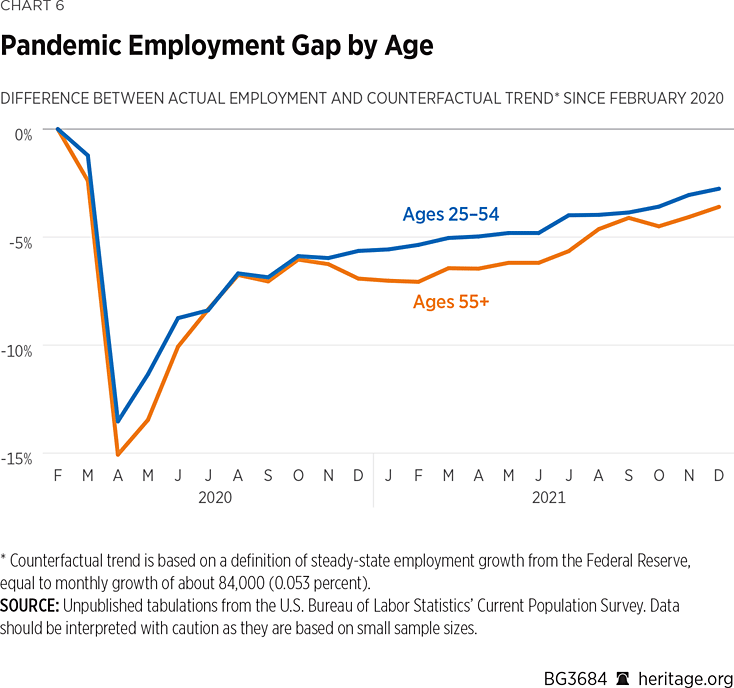
Parents vs. Non-Parents. Initially, parents’ employment fell by significantly less than that of non-parents, as the employment gap for parents was 11.8 percent in April 2020 while the gap for non-parents was 17.6. percent. (Parents are defined here as having one or more children under age 18 living in the home.) This likely had to do with parents tending to have more seniority than younger, childless workers, and parents being less likely to work in lower-wage jobs that experienced larger employment losses. Parents likely also have stronger desires for work—being less willing to quit and more likely to accept jobs—because of the need to provide for their children.
Parents consistently experienced lower employment gaps than non-parents until spring 2021, when that trend reversed. From March 2020 through February 2021, parents’ employment gap was 1.8 percentage points lower than non-parents, but between March 2021 and December 2021, parents’ employment gap was 2.1 percentage points higher than that of non-parents. As of December 2021, parents’ employment gap was 3.8 percent while non-parents’ was 2.1 percent.
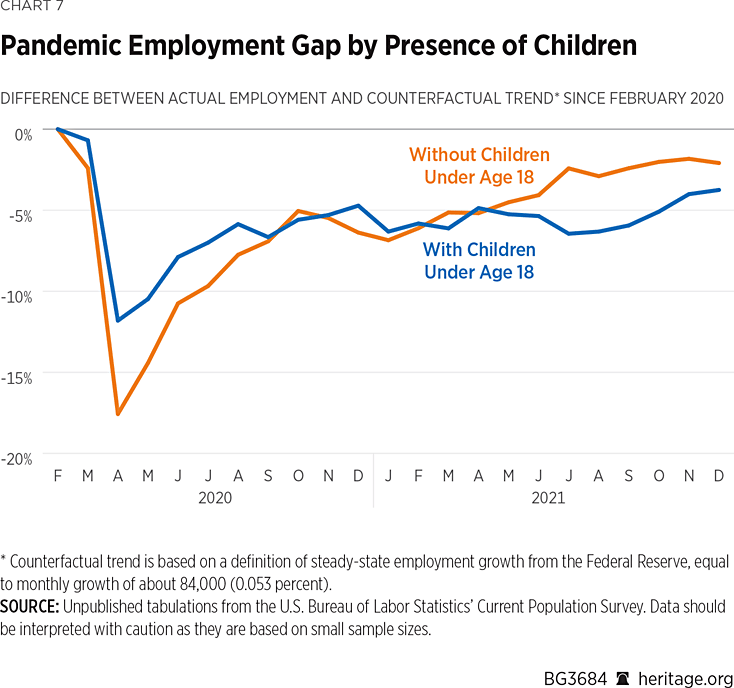
One possible explanation for the decline in parents’ employment relative to non-parents is that it coincided with Congress passing legislation in March 2021 that resulted in monthly child payments being deposited into parents’ bank accounts from July through December 2021. The fact that these payments were not conditional on work means that they made it easier for families to afford the things they needed and wanted with less work. A study by University of Chicago economists estimated that making those monthly child payments permanent would reduce parents’ employment by 2.6 percent, which is 1.5 million workers.REF Parents who stay home with children can be extremely beneficial for families and for society, but having at least one working parent in the home is crucial to breaking cycles of poverty. A disturbing finding from the University of Chicago study was that despite providing an additional $3,000 to $3,600 per year, per child, the payments would have zero impact on deep childhood poverty, which implies that a significant number of parents in low-income and single-parent households would drop out of the labor force entirely.
Young Children vs. School-Aged Children. Initially, parents with young children (under age six)—and particularly mothers—experienced larger employment losses than parents’ with school-aged children. That shifted in fall 2020, likely as a result of many schools closing for in-person learning, and the employment gap of school-aged parents exceeded that of parents with younger children.
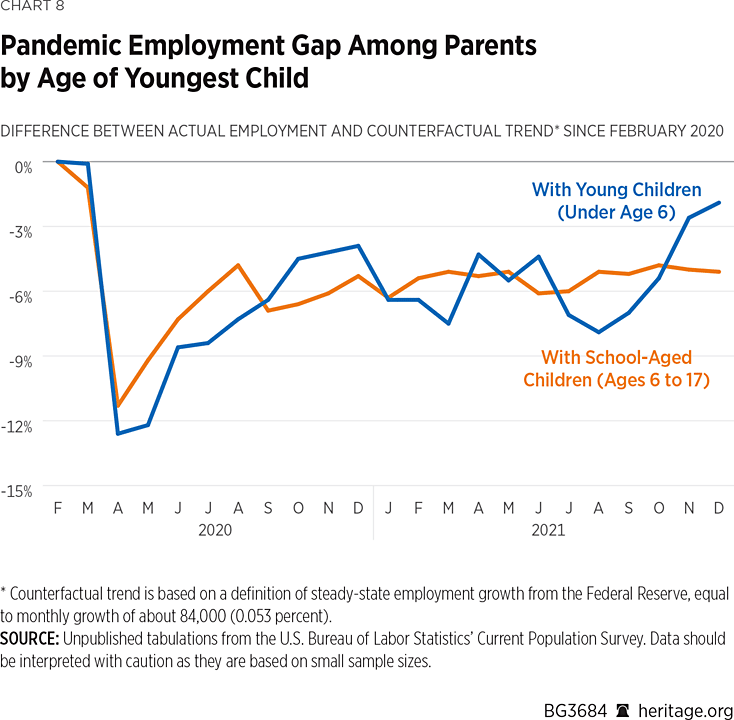
From January 2021 through October 2021, parents of younger children generally experienced larger employment gaps than parents of school-aged children, but that shifted rather dramatically in the last two months of 2021, as parents of young children made significant employment gains. As of December 2021, parents of school-aged children have a 5.1 percent employment gap, while parents of young children have a 1.9 percent employment gap, which is significantly lower than the overall 2.6 percent employment gap, and lower than any other demographic group considered in this analysis (with the exception of the subset of men with young children). As of December 2021, parents with school-aged children make up 36 percent of the total employment gap while parents of younger children make up only 9.6 percent of the overall gap.
Looking at the gender breakdown of parents with children as of December 2021, men with young children have the lowest employment gap of only 0.8 percent. The next-smallest gap is women with young children at 3.1 percent; parents with school-aged children have similar employment gaps of 5.1 percent for men and 5.2 percent for women.
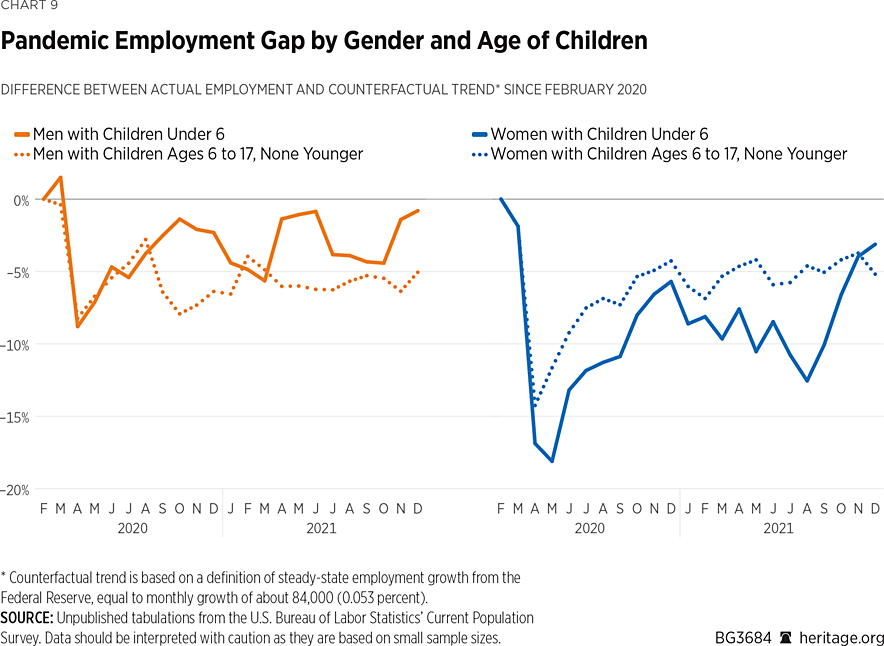
COVID-19 Impact
Health concerns about COVID-19 have certainly held some people back from employment, especially before the vaccines became widely available. However, the data indicate that fears of COVID-19 are not a significant factor in current labor shortages.
In May 2020, the Bureau of Labor Statistics began collecting data related to the COVID-19 pandemic, including asking people who are not in the labor force if they had not looked for work in the past four weeks because of the coronavirus pandemic. This includes people who are fearful of catching the virus, as well as other pandemic-related reasons, such as a business closing or a change in circumstances related to COVID-19.
In May 2020, 9.5 percent of all people not in the labor force—9.7 million people—said that they had not looked for work in the previous four weeks because of the coronavirus pandemic. That number has declined significantly, and as of December 2021 includes only 1.1 percent of people not in the labor force—1.1 million people.
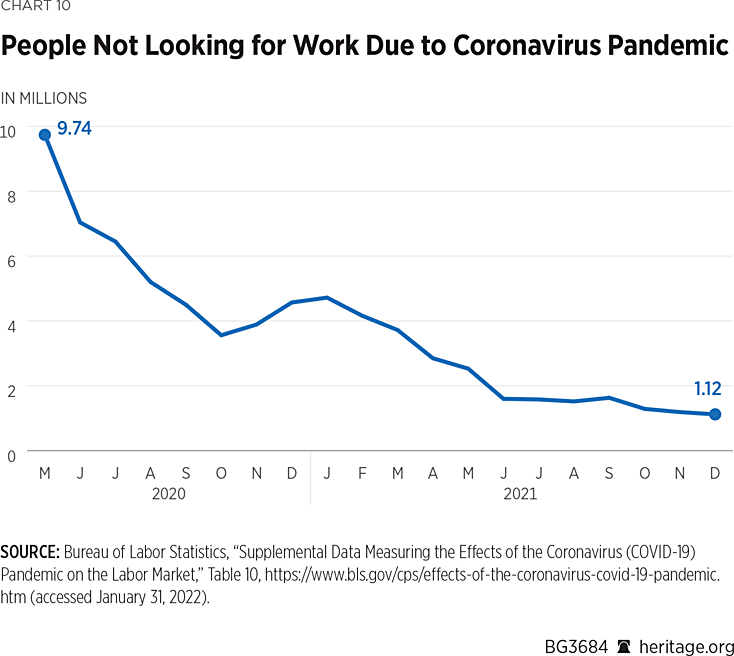
The surge in COVID-19 cases from the omicron variant has significantly increased worker absences in late 2021 and early 2022. Those temporary absences should not—in and of themselves—reduce employment levels. It is generally illegal for employers to fire workers who need to take time off to recover from COVID-19, and the severe labor shortage has made employers more reluctant than ever to let workers go. It is possible, however, that vaccine mandates (both public and private) and school closures related to the pandemic could be weighing on employment levels, particularly in industries (such as health care) where vaccine mandates are more widespread.
Policies to Promote Stronger Employment
The current labor shortage has become highly problematic. Almost two years since the start of the coronavirus pandemic, the virus itself is not the primary cause of this shortage—rather, it is many of the policies enacted in the name of preventing the spread of COVID-19.
Employment remains well below where it should be for virtually all subsets of workers, proving that the labor shortage is not a result of factors—such as childcare struggles or disparate impacts of the pandemic on women—that certain lawmakers have claimed as reasons to enact new unfunded entitlement programs and to expand the government’s influence over people’s lives.
Considering the ways that policymakers’ actions—many, but not all, enacted in the name of COVID-19 prevention—contributed to the labor shortage and continue to weigh on employers and consumers, there are a number of steps that policymakers should take to alleviate the current labor shortage. These include policies that ensure that work pays, and that not working does not pay. Federal and state policymakers should:
- Reduce taxes on workers, employers, and investments. The more one taxes something, the less one gets of it. Thus, lowering taxes will increase the returns to work, enable businesses to employ more people and pay them more, and promote investments in education and technology that increase worker productivity and thus worker pay.REF
- Let people pursue the work they want. Not everyone can work a traditional 9-to-5 job, many people want to be their own bosses, and workplace flexibility is high on many people’s priorities. That is why one of three workers in the U.S. participates in freelance work (also known as independent work, contracting, or gig work). The more control that people have over their work, the more work they perform.REF Policymakers should not enact laws that prohibit companies from doing business with independent workers, and policymakers should clarify the definition of “employee” across federal laws according to the level of control the individual maintains over his work.
- Expand accessible, affordable childcare. Childcare is critical for parents of young children who want or need to work, but it needs to be the type of care that parents want. State and local lawmakers can help to reduce costs and expand supply by eliminating costly regulations that do not improve safety or quality of care.REF For lower-income families, federal lawmakers should expand parents’ options by allowing families to use federal childcare subsidies and Head Start funds at a provider of their choice. Not only does Head Start have lackluster outcomes, but its limited hours of operation—effectively a preschool program—mean that it is often not a viable childcare solution for working parents.REF
- Make welfare work better through work-oriented programs. President Bill Clinton quoted Robert Kennedy when he said: “Work is the meaning of what this country is all about. We need it as individuals, we need to sense it in our fellow citizens and we need it as a society and as a people.”REF Work is crucial to breaking cycles of poverty and dependence, which is why the primary goal of welfare should be to help individuals and families to thrive by empowering them, through work, to earn a living that allows them to make their own decisions and pursue their own goals. Welfare programs for work-capable individuals must be tied to work.
Conclusion
Work is fundamental to American society and to human flourishing. The recent drop in work and labor force participation—particularly among working-age adults without dependents—is troubling. Today’s employment gap equals about 4.1 million workers, which is 2.6 percent of the workforce. Job openings, at 10.9 million, remain at record highs, and record percentages of employers report unfilled positions and compensation increases.
The current labor shortage is affecting the entire American economy, including business struggles, shortages of goods and services, supply chain issues, high inflation, and rising deficits. Continued low levels of employment will reduce the rate of economic growth, reduce real incomes and output, result in greater dependence on government social programs, require higher levels of taxation, and exacerbate the U.S.’s already precarious fiscal situation.
Easing the labor shortage requires creating an environment in which more Americans want to pursue, and are able to maximize, their productive capabilities. Policies, such as lower taxes on workers, businesses, and investments that enable people to work in the way that is best for them, and making childcare more accessible and affordable, can help to increase the returns to work. Removing work disincentives from America’s entitlement and welfare programs and measuring success by how many people government programs help to climb out of poverty—rather than how many people enroll and stay in the programs—will expand opportunities and personal and societal well-being. Finally, policymakers should learn from the unintended consequences of many COVID-19 policies, ending those that remain and refraining from creating new or expanded policies that would discourage work.
Rachel Greszler is Research Fellow for Economics, the Budget, and Entitlements in the Grover M. Hermann Center for the Federal Budget, of the Institute for Economic Freedom, at The Heritage Foundation.



